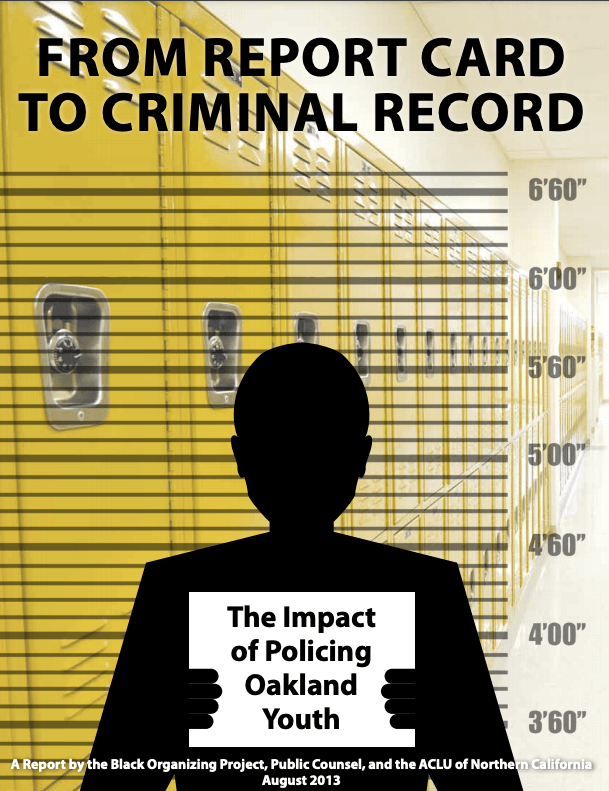Article Media

In the name of public safety, Black children in Oakland are being arrested at vastly disproportionate rates. This derails their opportunities for educational success while failing to ensure our children’s safety. From Report Card to Criminal Record: The Impact of Policing Oakland Youth describes the various and overlapping law enforcement agencies which police Oakland’s children. It reveals disturbing trends in disproportionate arrests and law enforcement contacts with youth of color, coupled with the underfunding of counselors, mental health professionals, and others whose presence could work to reduce the need for law enforcement.
The information contained in this report comes from data obtained directly from Oakland Unified School District, the Oakland School Police Department, the Oakland Police Department, and Alameda County Probation.
Among the report’s key findings:
- Over a seven year period, Black youth were, on average, 73.5% of all juvenile arrests by the Oakland Police Department each year, even though they make up just 29.3% of the Oakland youth population.
- Black youth were referred to the Alameda County Probation at more than two-and-a-half times their percentage in the population. This means they are six times more likely than Hispanic youth, and 23 times more likely than White youth, to be arrested and referred to Alameda County Probation.
- For arrests reported by the Oakland School Police Department during the last two years:
- While Black youth made up only 30.5% of the district’s student population, they made up 73% of Oakland School Police Department’s 85 arrests;
- Oakland School Police Department did not report a single White student arrest.
- OUSD reports employing only 20.5 school counselors, or one school counselor for every 1,854 students.
In addition to data obtained from these agencies, the report shares findings from the Black Organizing Project’s survey about community and youth perceptions of school police and alternatives for school safety. The survey answers uncovered that a majority of students surveyed dislike the presence of school police on campus and would prefer to implement alternatives to keep schools safe.
The report also reviews national research that shows, among other things, that arrests and contact with the juvenile justice system are significant contributors to high rates of school pushout and negative future outcomes for youth.
Also outlined in this report are specific, research-based alternatives to policing that work, such as Restorative Justice, Positive Behavior Interventions and Supports and reinvesting in caring, competent school counselors. We therefore call on OUSD administrators, city leaders, law ii enforcement entities, community members, and other stakeholders to take immediate steps to address these serious concerns, including:
- Implement Positive Behavior Intervention and Support practices in all OUSD schools and rely on Restorative Justice models as the first line of intervention for mediating student behavior.
- Make a far greater investment in counselors and mentors going forward.
- Develop and implement a meaningful memorandum of understanding between OPD and OUSD that clearly defines and limits the role of OPD officers in and around campuses, requires OPD to eliminate disproportionate arrest of youth of color, and allows for data review and monitoring by OUSD.
- Create a policy internal to OUSD in partnership with parents, students, and the community that outlines when and how to use law enforcement agencies for serious safety threats and criminal behavior and eliminates disproportionate contacts and arrests of Black youth.
